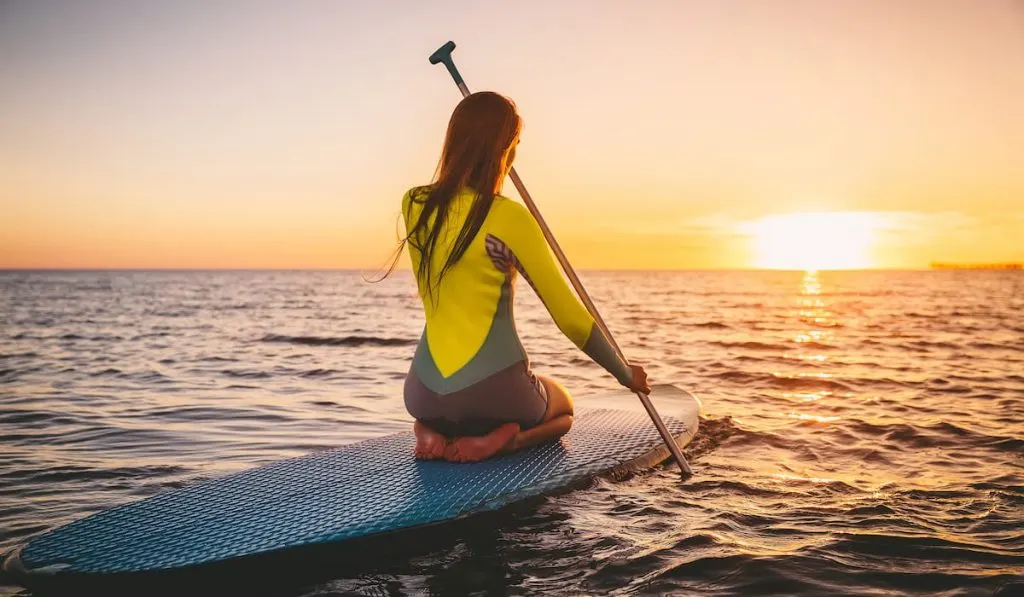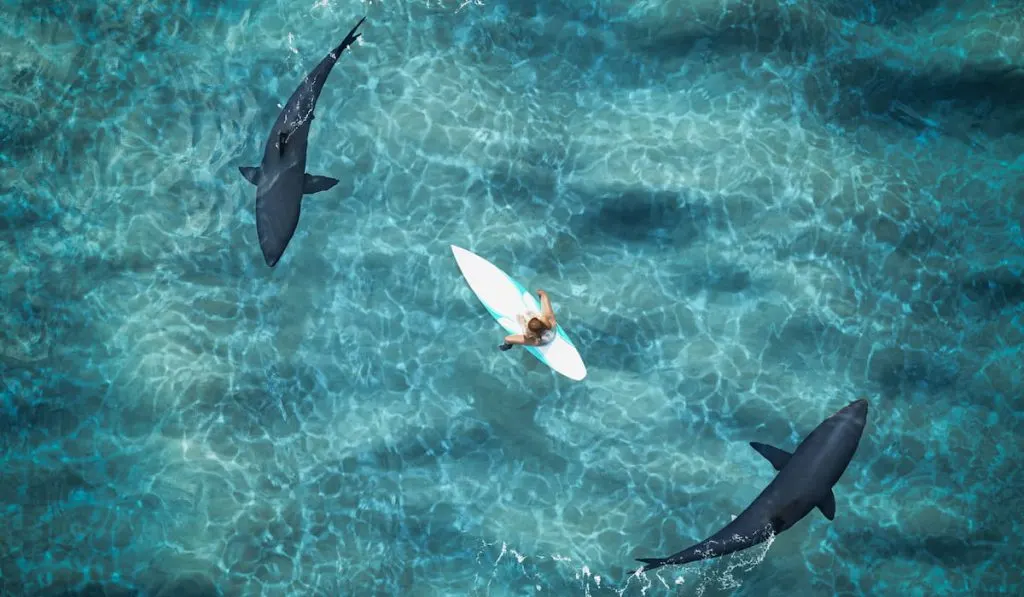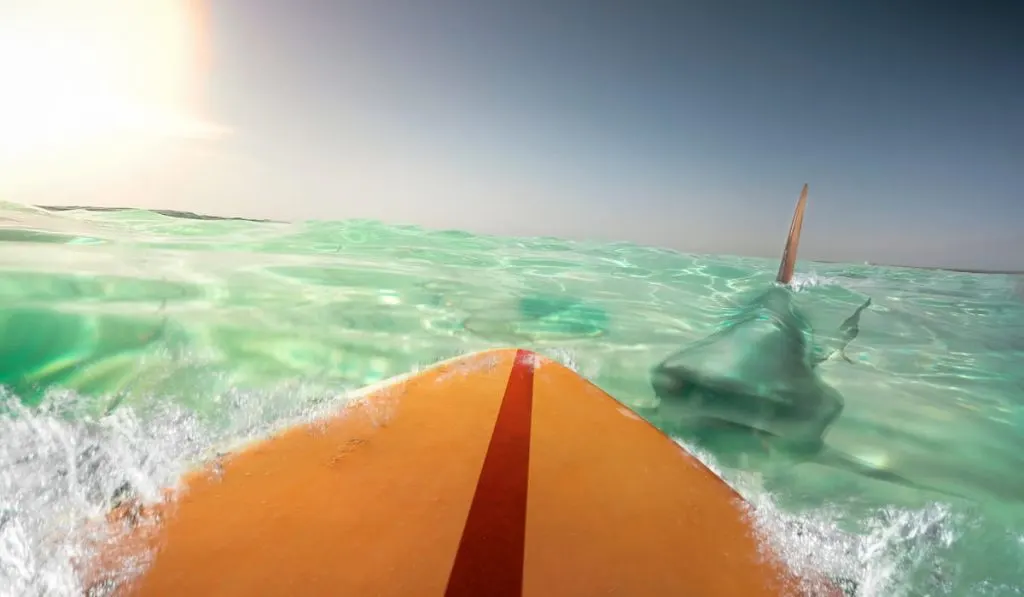If you’re new to ocean water sports, the thought of straying far from the beach can be anxiety-inducing. For many folks, everything is fine as long as you can stay relatively close to the shoreline.
If the water is clear, it’s easier to go further out, but there is still worry about things like jellyfish, stingrays, and other creatures that you don’t see every day while you’re on land.
Paddleboarding is one of those sports where you have to go a bit further out to have the most fun. First, you need space. You don’t want to be running into people playing in the water or swimming.
You also don’t want to constantly be fighting against waves crashing against your board that makes it almost impossible to stay balanced.
But while you’re far out in the water paddleboarding, will your board or the way you move attract sharks? A lot of people who’ve grown up around the ocean trade stories of how sharks mistake surfers and other people on boards for food.
Will that happen to you? Let’s explore how much of a risk a shark attack is to paddleboarders.

Shark Attacks Are Very Rare
It’s easy to understand why people worry about shark attacks. Much of the concern has to do with the fact that there is so much we don’t understand about sharks and what makes them go after a human.
When you’re out there on your board alone over calm water, it’s natural to start thinking about what’s lurking underneath. If you go on YouTube, you can see some pretty amazing clips of paddleboarders and their close encounters with some very large sea animals.
Still, a shark attacking a paddleboard is very rare. It does happen, but when you think about the frequency versus how many people are out there paddleboarding every day, the chances of an attack are very small.
Usually, the shark is mistaking the board for food. Perhaps it looks like a seal or a floating dead whale or dolphin, and a hungry shark may just go up and take a bite out of it to see what’s what.
That happened in 2017 in California when a shark swam up to a board and took a bite. The person on the board wasn’t hurt, and the shark swiftly swam away after it discovered there was no food to be had.
What’s more likely is that sharks see something new in the water, and curious sharks will get close to check things out. They don’t see humans as food, and shark attacks, for the most part, involve them taking a bite and splitting once they know it’s not what they want.
Still, no one can say shark attacks don’t happen against paddleboarders. Anytime you go out in the ocean, you take that chance, albeit a very small one.

How to React If You See a Shark
What should you do if you see a shark or multiple sharks swimming around you while you’re on a paddleboard?
Thankfully, most of the time public beaches do a good job of warning people about shark sightings. You’re not going to paddleboard a mile from shore in all likelihood, so you should take advantage of beach and shoreline advisories in your area.
If anyone in the area sees a shark, they report it to authorities, and those authorities then broadcast the message to beachgoers.
But what if you’re the one who spots the sharks? We know this is easy for us to say, but the best thing that you can do is stay calm. If you start flailing around, you could lose your balance and fall in. Once in the water, you’re exposed to the shark and have removed your only line of defense, your board.
Stay balanced and stay on your board.
Also, don’t try to get aggressive with the shark by swinging your paddles or splashing violently in the water. You might scare the shark away, but you may also scare it into defending itself against what it perceives as a threat. You could end up drawing the shark in instead of pushing it away.
What you should do is remove yourself from the situation as calmly and smoothly as possible. Start paddling to shore. Don’t make the mistake of thinking this is some “cool” or unique animal interaction that you want to be a part of.
Sure, plenty of people come in contact with sharks and nothing happens, but why would you want to take that chance? Head for shore and tell lifeguards or any other authorities on the beach about the shark sighting so they can take proper precautions for other people in the area.

Ways You Can Avoid Sharks While Paddleboarding
The ocean belongs to sharks, and we’re just visiting. That’s an important thing to remind ourselves whether we are out scuba diving or exercising on a paddleboard. In the water, we’re not at the top of the food chain anymore.
The best thing that you can do to avoid and prevent a shark attack is constantly monitoring the water around you while you’re out there.
We know water conditions vary based on time of year and where you paddleboard, but most of the time you should see a shark coming from a fair distance away. It will look like a shadow or dark spot moving through the water.
Unless they’re chasing down prey, sharks move fairly methodically and slowly, so it should be easy to track their movements and know where they are headed. You can start to move out of the way before you get up close and personal with any sharks.
Another thing that you can do is try to paddleboard during the day and when the weather is good enough that you have decent visibility in the water. That’s harder in some places than others, but seeing several meters into the water around you will help you stay safer.
Try not to paddleboard at night or in places where it’s hard to see where you’re going. You can also paddleboard in places where you know some shallow waters or sandbars will stop sharks from entering.
Sharks will generally avoid going into shallow water, so sticking to sandbars or avoiding going too far out will reduce the chances of any shark encounters.

Avoid Shark Feeding Times
You can limit your risk of any type of shark encounter by knowing when sharks are more likely to attack.
Again, sharks aren’t interested in humans as food. The rare shark attacks that do happen are most likely done out of curiosity or mistaking a person for a seal or some other food.
If you think about it, sharks don’t have hands. If they want to see whether something is food, they try to get up close, and then they take a nibble out of something to see if it’s what they are looking for. It’s one of the reasons why most shark attacks are a single bite and then the shark swims away.
Sharks generally hunt during dusk and dawn. Sharks already don’t have the best vision, so it’s likely they wait until the sun is coming up or down so their prey has a hard time seeing as well. However, when visibility is low, it’s also more likely a shark will confuse a paddleboarder with their prey when they’re hungry.
How Shark Attacks Usually Happen
Shark attacks on paddleboards happen in a few different ways. Sometimes, the shark will purposefully bump up against the board to sort of tap it to see what’s going on. If a person loses their balance, they fall into the water and start flailing around. The shark either mistakes the person for food or gets spooked and attacks because it is afraid.
In other attacks, sharks tend to come from the rear when they think you (or the seal they think they are attacking) aren’t paying attention. Sharks will often follow kayakers, boats, and paddleboarders for a while to check them out.
These types of attacks usually happen when you’re out on open waters in deeper seas. Obviously, these types of attacks are a concern because they are completely unexpected.
We’ve already mentioned that most of the shark attacks on paddleboards involve a single bite where the shark is simply testing to see what it is. They see something that could be food and decide to see how it tastes.

Knowing Which Types of Sharks Attack
You should also know that there are many different types of sharks. Part of being a responsible paddleboarder is knowing what sharks are in your area and what type of threat they pose to you or anyone else they come across.
Obviously, white sharks (Great White Sharks), bull sharks, mako sharks, and tiger sharks are involved in most attacks on humans. If you live in an area where these sharks frequent, then paddleboarding out in deep water may not be the best idea.
However, many other sharks, like nurse sharks, blacktip sharks, whale sharks, and others pose relatively little threat to humans. Know what’s in your area and take the proper precautions.
Understanding the Risk of Shark Attacks on a Paddleboard
Again, the risk of a shark attack is very low. Most paddleboarders will never see a shark while they’re out exercising. Even if you do see a shark, it probably will swim right by you.
If you’re worried about sharks, you can always go out in pairs or groups so that you have help or can help should anything bad happen. A shark is also less likely to attack anyone or anything when you’re not alone.
The most important thing is that you understand the risk and take appropriate measures to avoid a shark attack when you are out on the water.
